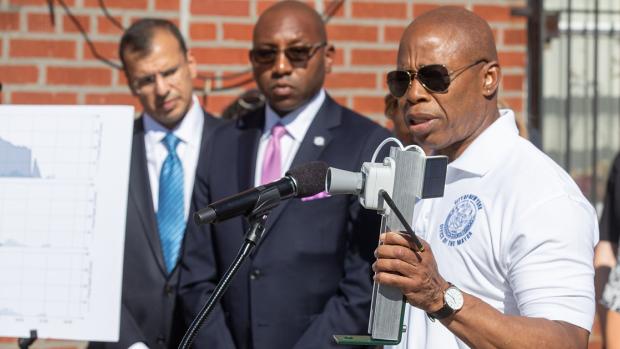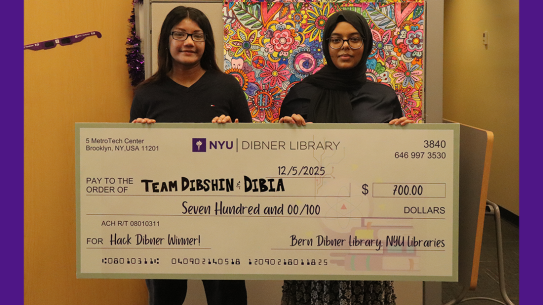FloodNet tracking system set for large expansion across all five boroughs thanks to $7.2 million from New York City
The flood sensor network monitors street-level flooding and flood threats in real time across New York City and shares the data through an open dashboard.

New York City Mayor Eric Adams demonstrates a FloodNet sensor at a press conference on Thursday, September 1, 2022.
NEW YORK, January 26, 2023 – FloodNet, the first-ever New York City flood-monitoring network, has received $7.2 million in city funding that will greatly increase the number of monitored flood-prone locations from 31 to 500 over the next five years. The network expansion is slated to begin in February.
FloodNet was developed and tested over the past two and a half years by a group of environmental researchers from Brooklyn College, the Science and Resilience Institute at Jamaica Bay, the Advanced Science Research Center at the CUNY Graduate Center (CUNY ASRC) and NYU Tandon School of Engineering in partnership with the NYC Mayor’s Office of Climate & Environmental Justice, the NYC Office of Technology & Innovation, and neighborhood community groups.
In addition to the sensor network, FloodNet also provides a free, mobile-friendly web dashboard that allows New York City residents and other stakeholders to monitor and react to flood threats in real time. Launched on the one-year anniversary of Hurricane Ida, the dashboard displays data collected by FloodNet’s expanding system of low-cost, open-source sensors across the city’s five boroughs.
Thirty-one FloodNet sensor devices are currently active in all five boroughs to monitor and collect water-level readings, which are delivered to an interactive map and data visualization platform in real time. The data platform allows users to see the occurrence and depth of flood water at each sensor location. The free-to-use dashboard makes it easy to know where, when, and how quickly flood waters are rising, either from overburdened stormwater drains or coastal seawater surges. The pilot web portal was created in partnership with FieldKit, with funding from the New York State Empire State Development Corporation.
About the dashboard:
- Displays a rich data set collected by the FloodNet sensors, including the depth and profile of street-level floods over time, which can be of use to community members, city agencies, researchers, emergency responders, journalists, and others.
- Provides flood data in real time as they are collected, and can alert users to floods as they develop.
- Includes a searchable map view that allows users to see at a glance which sensors are currently recording floods.
- Includes historical data, allowing users to explore and understand the frequency and severity of flooding in locations where FloodNet sensors are deployed, in addition to visualizing floods that occurred during specific events. For example, during Tropical Storm Henri (2021), FloodNet sensors deployed in the Gowanus neighborhood in Brooklyn recorded two distinct flood events on the same night separated by an hour during which the water receded. During Ida (2021), sensors recorded three feet of flooding at the intersection of Carroll Street and Fourth Avenue in Brooklyn, with flood waters rising quickly, peaking within 20 minutes, creating extremely hazardous conditions. Sensors located in coastal areas (e.g., Hamilton Beach and Rockaway, Queens) recorded two to three feet of flooding during the new moon high tide on December 23, 2022, due to elevated tide levels caused by the co-occurring winter storm.
- Visualizes regular flooding related to high tide events through data collected by flood sensors deployed in coastal neighborhoods.
The FloodNet project was developed as a collaboration between researchers at the Science and Resilience Institute at Jamaica Bay (SRIJB) at Brooklyn College, NYU Tandon’s Center for Urban Science and Progress (CUSP), and the Advanced Science Research Center at the CUNY Graduate Center (CUNY ASRC), in partnership with the NYC Mayor’s Office of Climate & Environmental Justice and the NYC Office of Technology & Innovation and with the financial support of the C2SMART Tier 1 U.S. Department of Transportation University Transportation Center at NYU Tandon, the NYU Marron Institute, and the CUNY Office of Research.
What they are saying about FloodNet:
-
"Information is power, especially when it comes to the devastating impacts of extreme flooding and coastal surge," said Deputy Mayor for Operations Meera Joshi. "Today's investment in real-time flood data means New York City will be better equipped to take action to protect lives, homes, and neighborhoods."
-
“FloodNet is a vital tool for improving our preparedness to climate change emergencies, and keeping at-risk communities informed about street flooding so they can make safety decisions in real time” said Mayor’s Office of Climate & Environmental Justice (MOCEJ) Executive Director Kizzy Charles-Guzman. “These low-cost, open-source sensors are already being used by those in flood-prone neighborhoods, and they are a prime example of a successful partnership between government and our academic institutions.”
-
“The city’s increased investment in FloodNet sensors will create an even more expansive, hyperlocal monitoring network that can alert New Yorkers in real time to dangerous flooding caused by intense rainfall,” said Chief Climate Officer and DEP Commissioner Rohit T. Aggarwala. “This life-saving, innovative technology will help us better understand and prepare for future storms, plan and build more resilient communities, and design and implement infrastructure that will more effectively manage extreme weather.”
-
“This administration is committed to harnessing the power of data to solve our city’s most pressing challenges,” said New York City Chief Technology Officer Matthew Fraser. “FloodNet’s expanded network will ensure that our city agencies, emergency responders, and residents possess the real-time knowledge they need to make informed public safety decisions when future storms threaten our city.”
- “Flooding is a major threat to life and property in New York City, and it is becoming a more frequent danger in the face of climate change,” said Brett Branco, Professor of Earth and Environmental Sciences at Brooklyn College and Executive Director of the Science and Resilience Institute at Jamaica Bay. “Our goal with FloodNet is to provide the street-level flood data and knowledge that enable communities, city planners, and policymakers alike to take actions that save lives.”
- “The beauty of FloodNet is that it uses very affordable, readily available technology to address an escalating problem that poses a tremendous financial and safety threat to New York City and its residents,” said Ricardo Toledo-Crow, Director of the CUNY ASRC’s Next Generation Environmental Sensor Lab, who helped lead the creation and deployment of the sensors along with Charlie Mydlarz at the NYU Center for Urban Science and Progress (CUSP). “The city’s investment in expanding the network’s reach will significantly enhance our ability to provide data that can assist government officials in creating strategies that address street-level flooding.”
- "We are extremely proud of the potentially life-saving work Brett Branco and the Science and Resilience Institute at Jamaica Bay are doing regarding flooding,” said Peter Tolias, Dean of the School of Natural and Behavioral Sciences at Brooklyn College. “The fact that this project also involves educating the next generation of researchers only proves how important these partnerships are as we move forward in advancing environmental issues in NYC.”
- "Creating a resilient New York City is a team sport, and I’m thrilled Tandon is a vital part of that team," said NYU Tandon School of Engineering Dean Jelena Kovačević. "This infusion of $7.2 million by New York City is a reflection of, and commitment to, the kind of unprecedented collaboration across government and academic institutions necessary to make life better for New Yorkers, and will enable enhanced data collection and provide a tangible framework for helping our most-often-flooded communities."
- “FloodNet sensors have demonstrated success in their preliminary deployment across all five boroughs over the last two and a half years,” said Andrea Sliverman, Assistant Professor at the NYU Tandon School of Engineering. “This new funding from the New York City Department of Environmental Protection will allow us to expand the sensor network to new neighborhoods and provide hyperlocal flood data to enhance the existing warning system for more New Yorkers. It will also create a robust data set upon which longer-term flood resilience strategies can be developed.”
About the New York University Tandon School of Engineering
The NYU Tandon School of Engineering dates to 1854, the founding date for both the New York University School of Civil Engineering and Architecture and the Brooklyn Collegiate and Polytechnic Institute. A January 2014 merger created a comprehensive school of education and research in engineering and applied sciences as part of a global university, with close connections to engineering programs at NYU Abu Dhabi and NYU Shanghai. NYU Tandon is rooted in a vibrant tradition of entrepreneurship, intellectual curiosity, and innovative solutions to humanity’s most pressing global challenges. Research at Tandon focuses on vital intersections between communications/IT, cybersecurity, and data science/AI/robotics systems and tools and critical areas of society that they influence, including emerging media, health, sustainability, and urban living. We believe diversity is integral to excellence, and are creating a vibrant, inclusive, and equitable environment for all of our students, faculty and staff. For more information, visit engineering.nyu.edu.
About The City University of New York (CUNY)
The City University of New York is the nation’s largest urban public university, a transformative engine of social mobility that is a critical component of the lifeblood of New York City. Founded in 1847 as the nation’s first free public institution of higher education, CUNY today has seven community colleges, 11 senior colleges and seven graduate or professional institutions spread across New York City’s five boroughs, serving over 243,000 undergraduate and graduate students and awarding 55,000 degrees each year. CUNY’s mix of quality and affordability propels almost six times as many low-income students into the middle class and beyond as all the Ivy League colleges combined. More than 80 percent of the University’s graduates stay in New York, contributing to all aspects of the city’s economic, civic and cultural life and diversifying the city’s workforce in every sector. CUNY’s graduates and faculty have received many prestigious honors, including 13 Nobel Prizes and 26 MacArthur “Genius” Grants. The University’s historic mission continues to this day: provide a first-rate public education to all students, regardless of means or background.
About the Advanced Science Research Center at the CUNY Graduate Center
The Advanced Science Research Center at the CUNY Graduate Center (CUNY ASRC) is a world-leading center of scientific excellence that elevates STEM inquiry and education at CUNY and beyond. The CUNY ASRC’s research initiatives span five distinctive, but broadly interconnected disciplines: nanoscience, photonics, neuroscience, structural biology, and environmental sciences. The center promotes a collaborative, interdisciplinary research culture where renowned and emerging scientists advance their discoveries using state-of-the-art equipment and cutting-edge core facilities.
About Brooklyn College (CUNY)
Widely known for its offer of an excellent education at an affordable tuition and recognized nationally for its diverse student body, Brooklyn College has been an anchor institution within the Borough of Brooklyn and greater New York City for more than 90 years. With approximately 16,000 students in more than 100 undergraduate and graduate degree programs in the arts, humanities, sciences, education, and business, the college is renowned for its rigorous academics, award-winning faculty, distinguished alumni, and community impact. Part of The City University of New York (CUNY), Brooklyn College offers a vibrant and supportive student experience on a beautifully landscaped 35-acre campus in the borough’s Midwood neighborhood.




